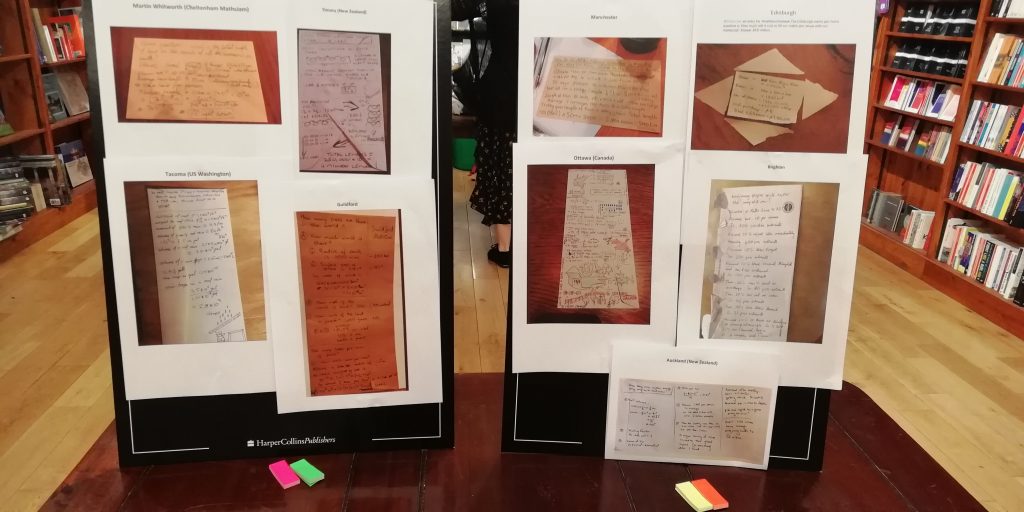
Aperiodipal and MathsJam regular Rob Eastaway organised an inter-MathsJam competition for last month’s events, challenging Jams to make Fermi estimates on the back of an envelope. The prize was a copy of his new book, Maths on the Back of an Envelope. Here Rob gives a summary of the entries he received, and shares his favourites.
Regular attendees of MathsJam will know that in September, Katie Steckles kindly allowed me to hijack the evening (in the nicest possible sense) by posing some envelope-related challenges, in celebration of the publication of my new book Maths On The Back Of An Envelope. In addition to some envelope-related puzzles, there was also an open challenge to Maths Jam groups to come up with their own back-of-an-envelope problems, with the chance to win the book as a prize.
The idea was for the each group to come up with an interesting ‘Fermi-style’ question, such as ‘How much beer will be drunk in UK pubs this evening?’, or ‘How many window cleaners are there in Denmark?’, and then submit their answers as scribbles on the back of an envelope. The most popular six entries, as judged by passers-by at a maths gathering in London, would win a free copy of the book. You can see all the entries by viewing the hashtag #mathsontheback.

The entries were imaginative and diverse, helped by the fact that you could enter from anywhere in the world. The furthest east entry came from Auckland in New Zealand, the furthest west from Tacoma in Washington state (if Tacoma rings a bell, it’s home to the world’s most famous formerly-wobbly bridge).
Looking at the entries, I realised that Fermi questions almost inevitably begin with the word ‘How’, and in the majority of cases, ‘How many…’. So for example Guildford posed the question ‘How many trees are there in the world’, for which they came up with an estimate of $5 \times 10^{12}$, which is 5 trillion. (This sounds plausible – there’s an international campaign called ‘One Trillion Trees’ which says we can counteract CO$_2$ emissions by planting this many new trees.)
On a similar theme, Ottawa wondered how many maple leaves there are in Canada. Their answer? The suspiciously precise 148 trillion. This doesn’t appear to be an outrageous number, since it’s 30 times bigger than Guildford’s number of trees. It would mean a mere 30 leaves per maple tree if all trees in the world were maples, but far more than that given that NOT all trees are maples.
Tacoma, the Washington people, also went with a nature theme, asking ‘How many raindrops fall on a typical house roof in a year?’ This does of course depend on what you mean by ‘typical’, since typical in the rain-drenched North West USA is rather different from typical in Doha. Anyway, 2.8 billion is their estimate. Sounds like a lot of rain, but then, I’ve been to Seattle and I can believe it’s true.
Two MathsJams were concerned with filling space. Edinburgh pondered on how much it would cost to fill their venue with mini toy sheep (their answer was £9.9m, which is a number that is crying out to be rounded up – a bit like their sheep). Meanwhile Auckland wondered how many cities in the world have enough table tennis balls to fill a bus (they reckon there are probably 100 cities that would qualify).
Most staggering number award surely goes to Cheltenham MathsJam, who estimated the total length of human hair on the planet as 70 light hours, or 3 light days, or 70 trillion metres if you prefer your measures to be in “illions”.
After that, the questions started to get a bit more off the wall. Manchester asked: ‘How far do drinks trolleys collectively trundle per day on trains in the UK (relative to the train)?’ I wonder if this is what stewards are thinking as they push the trolley up and down during a journey? Anyway, it’s 5400 km, apparently. Keeps them fit, I suppose.
From Timaru came the question ‘How many lemons will start a car?’. This isn’t a comment on a particular type of person who drives cars, but rather, it’s referring to those lovely experiments we did at school where we stuck wires into lemons and lit up an LED. Four lemons in series will light a 3V LED, or so Timaru claimed in their envelope scribbles, sounding like they knew what they were talking about. And hence, by extrapolation, four million lemons should do the job in sending your electric vehicle down the motorway. With the bonus that you’ll have a great resource for making lemonade and marmalade afterwards.
And then there was the meta entry from Brighton which was simply: ‘How many teams will enter this competition?’ Taking into account the total number of Maths Jams, then factoring in apathy, forgetfulness and the inability to find an envelope – as well as those groups that have a go but lose faith and chuck their entry in the bin – Brighton reckoned there would be four entries submitted in total. This turned out to be pessimistic by a factor of just over two. But still, it was in the right order of magnitude – and that, after all, is what Fermi questions are all about.